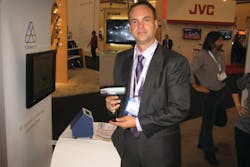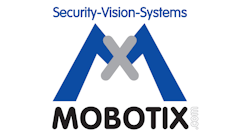When people talk about the latest and greatest innovations in surveillance cameras, the conversation tends to center around developments in image resolution and the continued migration from analog to IP. While there is certainly no shortage of cameras at this year’s ASIS show in Philadelphia with high image quality, there are some vendors showcasing developments in other areas of camera technology.
One segment of the market that has seen some advancement in recent years is the use of lenses to create a 360-degree field of view in a single camera. German-based video surveillance solutions maker Mobotix has been on the leading edge of this technology with the release of its Q24 hemispheric camera several years ago. At this year’s ASIS show, the company is featuring its S14 double hemispheric camera, which according to Steve Gorski, the company’s general manager for the Americas, provides users with a tremendous amount of flexibility.
"There’s really nothing like it in the marketplace today. Basically, you’ve got a processing box and two Q24 hemispheric cameras attached by a three-foot cable," Gorski explained. "You could have, for example, if you had two rooms next to one another you could put the processor box in the middle, extend one cable to one room with that camera and extend the other cable to the other room with the other camera and essentially cover two rooms with one camera."
Gorski believes the S14 is ideal for users looking for a camera that’s inconspicuous and would be a natural fit in retail and transportation environments. The company will soon be coming out with a special housing for the S14 that’s designed specifically for buses and trains.
In addition to the S14, Gorski said that Mobotix will also be highlighting some of the analytic capabilities that they’ve incorporated into the aforementioned Q24, which include a people counting application and heat mapping.
Gorski said he believes that some companies have fallen into the trap of the keeping up with the consumer marketplace in terms of creating cameras with more megapixels and have actually forgotten about meeting the real needs of the market.
"I think at the end of the day, the reality is yes, somebody may need a 15-megapixel camera for a certain application, but I don’t think everybody does,” he said. "Resolution is very important. There is no question about that. I think that’s the biggest argument for IP over analog. I think where people have fallen into the trap is applying some of the trends they’re seeing in the consumer electronics side and saying 'now I have to have a 10-megapixel, 15-megapixel or 20-megapixel camera.' And I think we’ve gotten away from asking the question; do you really need that?"
Gorski feels that future innovations in the industry will continue to focus on higher image resolution, but also more intelligent devices with greater analytic functionality, as well as move towards storage at the edge.
"I think it’s just going to be more and more intelligent products. I think that’s one of the benefits of IP certainly over analog," he said. "Like a lot of things in the electronics industry, things will probably get smaller, faster and less expensive."
Another important, but often overlooked component of camera technology is how they are powered. Innovation in Power-over-Ethernet solutions have allowed end-users to cut down on their installation and infrastructure costs, but one power option that has remain relatively untapped is solar energy.
MicroPower Technologies, a venture capital-backed startup company out of San Diego, is looking to change that with its Helios camera system. According to John Graham, the company’s vice president of sales and marketing, the Helios solution is a standalone camera system for perimeter security applications that removes the need for having any wires or cords.
"Our core competency is really the wireless link, which allows us to have high-reliability video to a network from a remote camera up to half a mile away," Graham said. "From a customer standpoint, corporations that are looking to add security to their perimeters, it’s very difficult to do so without having to dig up parking lots and lay cables over extended distances."
Graham said they believe their solution is ideal for a variety of vertical markets, including transportation, campuses and corporate parking lots. The system is really designed for any application that need a camera deployed quickly and effectively, he added.
"Wireless systems can be a bit of a bear at times, but we simply point the directional antennas in the approximate direction of the hub and vice versa from the camera and you’re off to the races," he explained. "We’re a fairly unique beast. Our business really enables (the traditional camera industry) to have new business models. We’re supplying a camera that physically doesn’t exist right now. People have tended not to put cameras on the perimeter simply because of the costs involved."
The Helios camera only consumes about 500 milliwatts of power, while the solar panels can generate 10 watts of energy. The camera’s batteries can also run constantly for five days without a recharge and can be recharged up to 3,000 times, which makes it unnecessary to have a backup.
"Unless you put a bag over the camera where it’s not getting any sun at all, the solar power system is actually pretty reliable," Graham said. "In the cases where someone puts it up in northern Canada and the winter light just isn’t there, we actually have an additional solar panel accessory which is about the size of an iPad. You hang that above the camera pointing South and that will supplement the existing system and ensure that you have enough sunshine wherever you are 365 days a year."
Also at the show, Graham said that MicroPower is announcing its certification with Milestone and Genetec’s video management software platforms, as well as interoperability with Sprint’s 4G cellular network. The company is bringing their solution to the market through systems integrators and has a direct sales force that puts resellers in front of end-users customers.
While there are other solar-powered surveillance solutions on the market, Jon Siann, president and CEO of MicroPower, said that many of them are unreliable.
"A lot of it just doesn’t work. Our goal is to make it work in all conditions,” he said. “The systems integrator doesn’t have to worry about it."
Siann estimates that companies could easily save $50,000 to $60,000 alone in costs related to installing traditional perimeter security cameras by using the Helios camera.
Though they have long been known for their camera housings, which are used by several well-known camera makers, Moog also recently entered the security camera market and is displaying its EXO Series of cameras at this year’s ASIS show. The EXO Series, which features six different models - anti-corrosive, bullet resistant, explosion-proof, impact resistant, pressurization, and surface mount – are ideal for applications that are subject to harsh environmental conditions.
Chris Lindenau, Moog’s director of business development and sales, said that the company is specifically targeting the extreme conditions camera market, which is where they believe they can carve out a niche for themselves and standout from the competition.
"What we’ve realized (about traditional camera vendors) is they’re less keen on getting into extreme environments," he said.
According to Lindenau, Moog’s cameras are exclusively designed and manufactured in the U.S. and can withstand temperatures ranging from 50 degrees below Celsius to 74 degrees Celsius. When the company decided two years ago to start making cameras in addition to housings, Lindenau said they weren’t going to import cheap foreign components.
"We’re going to build everything from the ground up," he said of their strategy.
Unique advancements can also be found in the traditional camera market at this year’s show. Such is the case with Irvine, Calif.-based Innovative Security Designs, which was started late last year and has two products on the markets today – an auto-focus and CS version of its Jaguar camera.
"The critical difference (between ISD and the rest of the market) and really the focus as to why I started ISD was the world does not need another camera company," said ISD CEO Ian Johnston. "The goal of ISD was not to create just another camera company, the goal was to create a great platform on which to showcase new ideas, as well as just have really good image quality, edge storage and platform for everything."
According to Johnston, ISD is trying to take a different approach to the market that what has been done in the past, which he believes has resulted in largely "clumsy" and "expensive" surveillance technology.
"The camera just being a standalone device that captures video is becoming pretty archaic," he said. "Now that edge storage is becoming pretty viable in the fact that you can buy 128-gigabyte card from Amazon, throw it in a camera and actually have edge storage and have the storage be more distributed across your entire network – people are now starting to realize how everything is architected."
As with the transition from motion JPEG to H.264 compression, Johnston said that there is a lot of backlash now in the industry against edge storage because they’re incapable or unwilling to produce a product with that capability.
"The first thing was the backlash against IP with the analog companies saying IP is bad. Then it was the backlash against H.264 that it was bad. Now, you’ll see a backlash against the edge whereas everybody else is claiming that they can do it, so it is an interesting transition," he added.
While there has been a debate in the industry over the benefits of megapixel and HD resolution, Johnston said that the "sweet spot" for security is 720P and 1080P with 1080P making up the bulk of the marketplace.
"Any resolution above that… the reality is the optics behind everything, it just doesn’t support anything greater than 1080P," he explained. "So, if you go with off-the-shelf security optics with what’s commonly available through most vendors, anything above 1080P is just basically wasting bandwidth and wasting money."
Johnston believes that in the future, security camera will be ubiquitous as they are today in China and the UK to a certain extent and that the challenge will be how these cameras are integrated and how footage is retained.
"You have all of these devices, how you tie them together, how you manage them and how you access them all is becoming pretty unwieldy and that’s where edge, cloud and VSaaS – it’s finally starting to take root I think in a meaningful way," Johnston said. "The interesting thing is the hardware now is to the point to where it’s actually starting to be viable. The Jaguar camera that we’ve come up with, it’s actually faster and has more memory than the PC I had in college. Now that the technology is catching up to the expectation of the customer and what they would like to be able to do and all of the cloud infrastructure… you can tie all of these things together and actually go for a viable solution, but it does require a certain amount of imagination and the ability to cross-pollinate different industries, which traditionally in the security industry has been pretty lacking."




